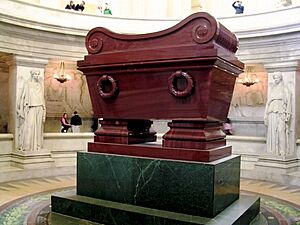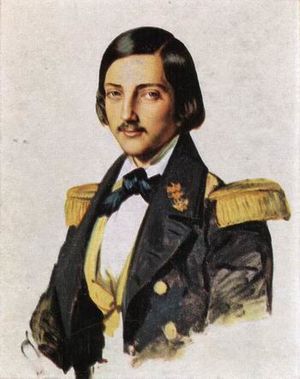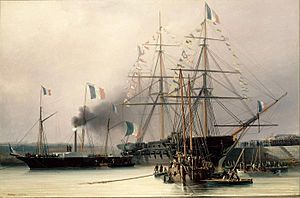Retour des cendres facts for kids
The retour des cendres means "return of the ashes." It was when the body of Napoleon I, a famous French leader, was brought back to France from the island of Saint Helena. He was buried in a special place called Hôtel des Invalides in Paris in 1840. This idea came from Prime Minister Adolphe Thiers and King Louis-Philippe.
Contents
Why Napoleon's Body Came Home
Napoleon's Exile
After losing a big war in 1814, Napoleon had to give up his power. He was sent away to a small island called Elba. But he came back to France the next year and tried to rule again for "100 days." Other countries teamed up and defeated him at the Battle of Waterloo. Napoleon gave up his power again in 1815. He tried to go to the United States but couldn't. So, he surrendered to the British. They sent him far away to Saint Helena, a tiny island in the Atlantic Ocean. Napoleon died there in 1821.
His Last Wish
Before he died, Napoleon wrote in his will that he wanted to be buried in France. He wished to rest "on the banks of the Seine River, among the French people [whom he] loved so much." After Napoleon passed away, his friend Comte Bertrand asked the British government to let his wish come true. They said no. Then, he asked the new French king, Louis XVIII. The king didn't say no completely. He explained that bringing Napoleon's body back might cause trouble in France. He said it could happen later when things were calmer.
Getting Permission to Return
Political Talks Begin
Years later, in 1830, some people asked for Napoleon's body to be buried in Paris. But this idea was turned down. Ten years later, in 1840, Adolphe Thiers became the new prime minister. He was also a historian who studied Napoleon's time. Thiers thought bringing Napoleon's body back would be a huge political event. He hoped it would make the government, called the July Monarchy, look good. It would also make people happy who admired Napoleon.
King Louis-Philippe wanted to celebrate "all the glories of France." But he wasn't sure about this plan. Some of his family members also thought it was a bad idea. For example, his son, the Prince de Joinville, didn't want to be involved in what he called a "carter's" job. His wife, Queen Marie-Amélie, thought it would cause problems.
In early 1840, Thiers's government formed a committee. This group of twelve people would decide where Napoleon's tomb would be. They also chose the architect. On May 10, 1840, the French ambassador in London, François Guizot, officially asked the British government for the body. The British quickly agreed, just as they had promised in 1822.
The News Spreads
On May 12, 1840, the French Interior Minister, Charles de Rémusat, announced the plan. He told the Chamber of Deputies (like a parliament) that the government wanted to bring Napoleon's body back. They also asked for money to build his tomb at Les Invalides. This news caused a big stir! People started talking and arguing about it. Some even suggested burying him in other famous places in Paris.
On May 25 and 26, the plan was discussed in the Chamber. An old soldier named Bertrand Clauzel supported the idea of Les Invalides. Other people spoke, some against it, some for it. Lamartine, a famous writer, thought it was dangerous. He said that "Napoleon's ashes are not yet extinguished." He meant that Napoleon's ideas could still cause trouble. Even so, most of the Chamber voted yes. They agreed to pay for the return of the body.
Special Ceremony
In June, General Bertrand met King Louis-Philippe. The king gave Bertrand Napoleon's weapons, which were then put in a special treasury. This upset Napoleon's relatives, Joseph and Louis-Napoléon Bonaparte. Louis-Napoléon wrote a letter saying the king was trying to make himself look good.
The Journey from Saint Helena
Setting Sail
On July 7, 1840, a French ship called Belle Poule left France. It was led by the Prince of Joinville, King Louis-Philippe's son. Other important people were on board, including generals Bertrand and Gourgaud, who had been with Napoleon on Saint Helena. There were also five of Napoleon's old servants. The ship was specially prepared. A chapel was built inside, decorated with black velvet and Napoleon's symbol, silver bees.
The trip took 93 days. The ships stopped in several places, like Brazil, where they had parties. They finally reached Saint Helena on October 8. There, they learned that France and Britain were having some diplomatic problems. The Prince of Joinville worried that British ships might try to stop them on the way back.
At Napoleon's Tomb
The next day, the French group met the island's governor. He told them Napoleon's body would be given to them on October 15. The group then went to Napoleon's tomb. It was in a quiet valley, covered by three simple stone slabs. A weeping willow tree shaded the spot. The tomb was very plain. The group stood in silence, looking at the grave. They also visited Longwood, the house where Napoleon had lived. It was in ruins, and his bedroom had become a stable.
Opening the Coffin
At midnight on October 14, the team returned to the tomb. British soldiers began to dig. They removed the stones and slabs covering the grave. After a lot of effort, they reached the coffin. It was 9:30 AM. A priest blessed the coffin. Then, they carefully opened the outer coffins. There were several layers: mahogany, lead, another mahogany, and finally, a tin coffin.
When the last lid was lifted, everyone was amazed. Napoleon's body was very well preserved! His face was easy to recognize, and his eyes were closed. He looked peaceful. His famous green uniform was still in perfect condition, and the red ribbon of the Legion of Honour was on his chest. His hat was resting on his legs.
Everyone watching was deeply moved. Many cried. A doctor wanted to examine the body more, but General Gourgaud quickly ordered the coffin to be closed. The body was sprayed with a special liquid to preserve it.
The original coffin was then placed inside a new lead coffin brought from France. This was put into a beautiful ebony coffin, which had Napoleon's name in gold letters. This heavy coffin, weighing 1,200 kilograms (about 2,600 pounds), was then put on a large funeral carriage.
Transfer to the Ship
At 3:30 PM, in the rain, the procession slowly moved towards the port. Cannons fired salutes. Napoleon's friends walked beside the coffin. When they reached the jetty, the body was officially handed over to France. The heavy coffin was carefully placed into a special boat. All the French ships raised their flags and fired their guns.
On the Belle Poule, 60 sailors stood ready. Drums played a salute. The coffin was brought onto the deck. A priest gave a blessing, and Napoleon was finally back on French land. The coffin was placed in a special chapel on the ship.
The Return Voyage
On October 18, the Belle Poule and another ship, Favorite, set sail for France. They sailed quickly, worried about being attacked by British ships because of the political tensions. The Prince of Joinville even ordered the Favorite to sail ahead to a French port, just in case. He knew no one would attack the ship carrying Napoleon's body, but the other ship might be in danger.
On November 27, the Belle Poule was close to France. The crew kept taking precautions, even though the tensions between France and Britain had eased.
Arrival in France
A new government had taken over in France. They were worried about the return of Napoleon's body. They wanted to finish the ceremony quickly. The Interior Minister said the funeral would happen on December 15, no matter the weather.
Everyone in Paris worked hard to prepare. Huge decorations were put up along the route from the Pont de Neuilly bridge to Les Invalides. The funeral carriage was enormous. It was 10 meters (33 feet) high and weighed 13 tons! It was pulled by 16 horses. The carriage was covered in gold and purple velvet, decorated with golden bees and eagles.
The government wanted the ceremony to be mostly military. They didn't want big crowds of civilians, fearing protests. This upset students who wanted to be part of the procession.
On November 30, the Belle Poule arrived in Cherbourg. Six days later, the coffin was moved to a steamer ship. It traveled up the Seine River, where many people gathered on the banks to see it pass. On December 14, the ship reached Courbevoie, just outside Paris.
The Reburial Ceremony
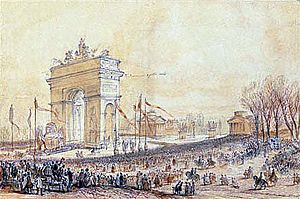
The reburial was set for December 15. Even though it was cold, a huge crowd gathered from the Pont de Neuilly to Les Invalides. People stood on rooftops to watch.
The procession arrived at Les Invalides around 1:30 PM. The king and many important leaders were waiting. The Prince of Joinville, who had brought the body back, gave a short salute. The king spoke a few words.
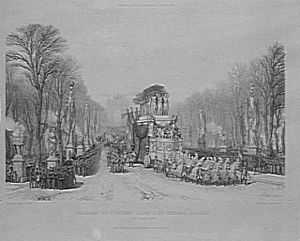
General Atthalin brought Napoleon's sword, which he had worn in famous battles. He presented it to the king. The king then asked General Bertrand to place the sword on the coffin. Bertrand was too emotional to do it, so General Gourgaud stepped forward and placed it there.
During the ceremony, famous singers performed Mozart's Requiem. The old Marshal Moncey, who was in charge of Les Invalides, was very ill. He had held on just to be part of the ceremony. At the end, he walked to the coffin, sprinkled holy water, and said, "And now, let us go home to die."
For several days after, Les Invalides remained open to the public. Many people had not believed Napoleon was truly dead. Some rumors even spread that the coffin was empty. But the real body was there.
What Happened Next
The return of Napoleon's body was supposed to make the July Monarchy more popular. Thiers thought it would show a new friendship between France and Britain. But it didn't work out as planned.
Most French people were excited, but they felt let down. The government had tried to keep crowds away, fearing riots. The procession mostly traveled by river, avoiding many towns. In Paris, only important people were allowed at the ceremony. The lack of respect from some politicians also upset the public.
The "retour des cendres" also didn't help France's diplomatic problems with Britain. France had to stop supporting its ally in Egypt. Thiers, who had pushed for the return, lost his job even before the Belle Poule arrived. He got the body back but couldn't benefit from his success.
Napoleon's Tomb
In April 1840, a competition was held to design Napoleon's tomb. Many architects submitted ideas. In 1842, Louis Visconti was chosen as the architect.
Visconti designed a circular space under the dome of Les Invalides. In the center is a huge sarcophagus (a stone coffin). It is made of a purple stone from Russia. This stone was chosen to remind people of the red stone used for ancient Roman emperors' tombs. The sarcophagus rests on a base of green granite from France. This green granite block sits on a large slab of black marble.
The monument took many years to finish. The purple stone from Russia was very difficult to get. It was quarried in 1848 and shipped to Paris, arriving in 1849. The sarcophagus was carved using new steam-powered machines. It was almost done by 1853, but Visconti died that year.
Finally, on April 2, 1861, Napoleon's coffin was moved to its final resting place in the new tomb. Only a small group of family members and officials were present, including Emperor Napoleon III, Napoleon's nephew.


